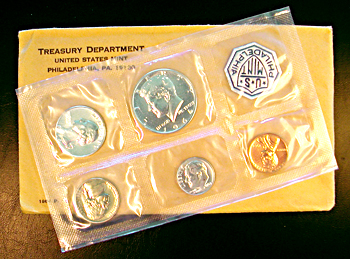Remembering When Kennedy Halves Were New
|
"Making Cents"
The Signal
Saturday, June 18, 2005
| I |
Well before opening, there was a line of 50 or more people outside the Cheltingham Bank, waiting to buy the new coins. I bought two rolls and brought them back to California for the next meeting of the Whittier Coin Club, where I was president. I thought it would be nice if the members could get a "P"-mint version of the new half dollar, straight from Philadelphia.
Much to my amazement, all were "D"-mint coins! Here I was, about 10 miles from the Philadelphia Mint, and the rolls of newly minted halves had come all the way from Denver.
I ordered 10 of the 1964 proof sets, and early in June, they arrived. The fever and excitement over the new Kennedy half dollar drove proof-set prices to $25 per set that summer. (The Mint's issue price was $2.10). As a result of the public clamor for the proof sets, the Mint did an unprecedented thing: In September, it announced it would issue another two million sets at $2.10 each.
The prices dropped off sharply, and the 1964 proof set traded at $6 to $8 for many years thereafter. When silver prices rose sharply in the late 1970s, all silver coins rose dramatically in value, and the 1964 Kennedy halves — the last of the 90-percent silver halves — were selling for $10 per coin.
Briefly in 1980, silver coins were selling at 22 to 24 times face value. By 1982, silver prices began to slide, and 20 years later, silver coins leveled off at three to four times face value.
Starting in 1965 and ending in 1970, Kennedy halves were minted in a 40-percent silver alloy — the first such coins with that alloy. The last issue, 1970, included a 1970-D specimen that was available only in Mint sets, and the 1970-S, which was available only in proof sets.
No 1970 halves were minted in Philadelphia that year, and the total number of 1970-Ds was just over two million pieces (about the same for the 1970-S). In 1965, 1966 and 1967, Kennedy halves were minted only in Philadelphia. Since 1968, all half dollars issued for circulation have been made of the copper-nickel clad composition that is also seen in dimes and quarters. Starting in 1992, a small number of silver proofs sets have been issued (with 90-percent silver dimes, quarters and half dollars).
Although Kennedy halves have been minted each year since 1964, some dates are particularly hard to find in circulation. Generally, except for certain states and localities, half dollars seem to have little commercial use at all. It would not be surprising to see the half dollar phased out as a "circulation" coin in the not-too-distant future.
Dr. Sol Taylor of Sherman Oaks is president of the Society of Lincoln Cent Collectors and author of The Standard Guide to the Lincoln Cent. Click here for ordering information.
©2005, THE SIGNAL · ALL RIGHTS RESERVED.
